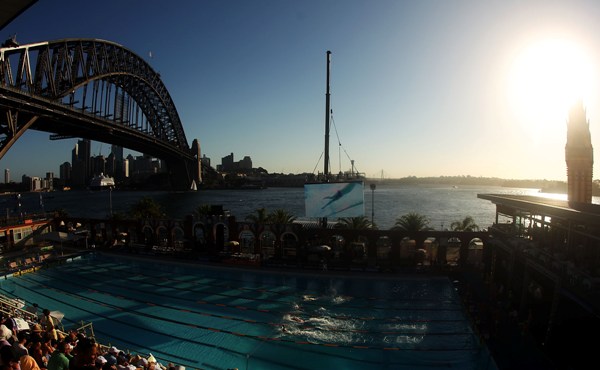Summer Swims, the Big Merino and Wet-Plate Technology
Australia’s track record of producing world class swimmers is often chalked down to a generous climate, a culture of loving water and a Kieran Perkins style of competitive spirit.
Whilst these attributes are worthy factors to Olympic and Commonwealth success, what is easily cloaked is the innovative and fascinating sports science that is employed to help tinker, mend and refine the techniques of our leading swimmers.
Whilst the Summer Swim Series was making waves at North Sydney pool by the sweeping backdrop of the Sydney Harbour Bridge last week, WAIS athletes Blair Evans, Travis Nederpelt and Kris Taylor had the opportunity to follow-up their race meet with a road-trip to the Australian Institute of Sport in Canberra to work with AIS swimming sports science guru Bruce Mason, to tap into the testing technology known as “Wet-plate”.
The trio were chaperoned by their City of Perth coach Matt Magee who believes that wet-plate testing can form a crucial part of the coaching analysis chain.
“For me, wet-plate testing is a priceless tool for measuring and recording starts, turns and finishes, as well as the technical items involved in the free-swimming phase of a race,” he said.
With Evans, Nederpelt and Taylor having competed in the Summer Swim Series – in which Nederpelt and Taylor claimed bragging rights over Evans as part of the victorious Susie O’Neill led team (see link at bottom of page) – it was left to Magee to Sheppard the flock from Sydney through some 287km down to Canberra, with just enough time to take in some iconic landmarks.
“After picking them up from the hotel at 5:30am, we drove the three hours to Canberra in perfect summer weather,” Magee said. “Nederpelt navigated, whilst Taylor and Evans slept in the back and it wasn’t long before we’d made good enough ground to stop off at the Big Merino in Goulburn,” Magee said.
The Big Merino is a 15 metre, 97 tonne concrete monument, which according to the official website is “a celebration of the Australian fine wool industry, showcasing fashion items from this brilliant and versatile natural fibre”.
Recharged and inspired, Magee’s road-trippers powered through to Canberra for the real focus of the AIS visit, which was to work hands on with Mason and his staff at extrapolating as much information and data from their stroke, which Magee believes will be well utilised back in their native Perth.
“The athletes had their starts and turns recorded, analysed and worked closely with our group to identify key areas of improvement, Magee explained. “From there we went back made adjustments and re-recorded the drills and skills. The information was placed on a hard drive which we brought back home to work with WAIS biomechanist Andrew Lyttle.”
Like all good road-trips the return leg included some humour from navigator-cum-web critic Travis Nederpelt.
“On our way back to Sydney we took a detour for some healthy snacks to last the journey and with Travis providing the entertainment via whacky YouTube videos before we knew it we were at the airport with two minutes to spare,” Magee joked.
For more information on the Summer Swimming Series, click here .




